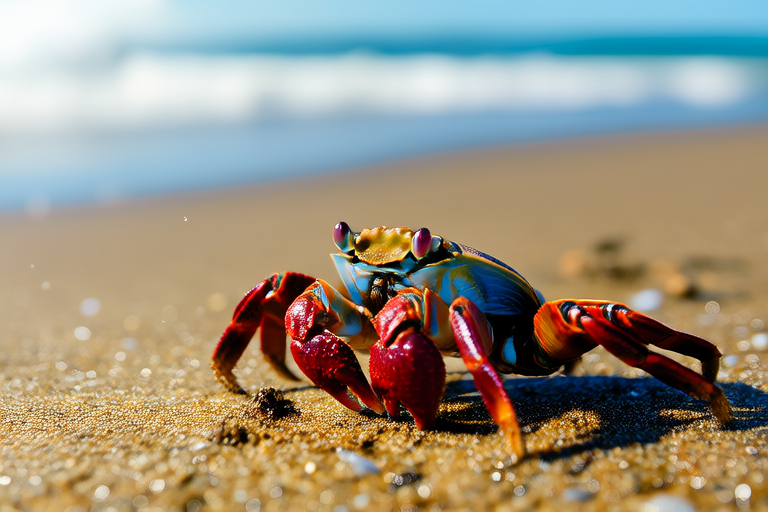From Seashore to Home: Transforming Your Space into a Hermit Crab Paradise
Hermit crabs are fascinating creatures known for their unique habit of living in empty shells. Their natural habitat is primarily along the seashore, where they thrive in warm, humid conditions. These small crustaceans have specific needs that must be met to ensure their well-being when brought into a home setting. Creating a hermit crab paradise involves understanding their environmental requirements and replicating their natural coastal environment as closely as possible.
The Coastal Habitat of Hermit Crabs
Hermit crabs are predominantly found in coastal regions, where they enjoy the warmth, humidity, and variety of resources available. Their natural habitat includes sandy beaches, rocky shores, and mangrove swamps. These environments provide hermit crabs with a steady supply of food, shelter, and the ability to molt safely. To replicate these conditions at home, it’s crucial to understand the key elements that make up their ideal environment.
Essential Elements for a Hermit Crab Habitat
Appropriate Substrate
The substrate, or the material covering the bottom of the tank, is one of the most critical components of a hermit crab habitat. In nature, hermit crabs burrow into the sand to hide from predators and maintain humidity levels. A mix of silica sand and coconut fiber is often recommended for a balanced substrate. This combination provides a soft surface for burrowing while also helping to retain moisture.
Water Dishes
Hermit crabs require both fresh and saltwater dishes in their habitat. Freshwater dishes should be placed in a shaded area of the tank to encourage drinking, while saltwater dishes should be positioned closer to the heat source. The saltwater dish serves multiple purposes, including facilitating molting and providing a place for hermit crabs to clean their antennae.
Climbing Structures
To mimic the rocky and varied terrain of a coastal environment, it’s important to include climbing structures in the tank. Hermit crabs are naturally curious and enjoy exploring vertical spaces. Rocks, driftwood, and commercial climbing toys can all serve as suitable structures. Ensure that any objects added to the tank are safe and free from harmful chemicals.
Temperature and Humidity Control
Maintaining the correct temperature and humidity levels is vital for hermit crab health. These creatures are ectothermic, meaning they rely on external sources to regulate their body temperature. An optimal temperature range for hermit crabs is between 75°F and 85°F (24°C to 29°C). A heat lamp or under-tank heater can help achieve this. Additionally, humidity levels should be kept between 70% and 80%. A hygrometer can monitor humidity levels, and a misting system can help maintain them.
Tank Size and Decorations
Choosing the Right Tank Size
The size of the tank is directly related to the number of hermit crabs you plan to keep. As a general rule, each hermit crab requires approximately 10 square inches of floor space. However, more space is always better, especially if you want to accommodate larger crabs or a diverse collection of species. A larger tank also allows for more complex and stimulating environments.
Stimulating Decorations
Decorations in the tank should not only look appealing but also encourage natural behaviors. In addition to climbing structures, consider adding caves, tunnels, and other hiding spots. These features provide hermit crabs with places to retreat when feeling threatened or during molting periods. Avoid sharp or toxic materials that could harm your pets.
Diet and Transition Tips
Proper Diet
A balanced diet is essential for hermit crab health. Offer a variety of foods, including fruits, vegetables, protein sources, and commercially available hermit crab food. Fresh produce like apples, bananas, and carrots should be washed and cut into small pieces. Protein sources such as fish, shrimp, and boiled eggs can be offered sparingly. Always remove uneaten food promptly to prevent mold growth.
Ensuring a Stress-Free Transition
Bringing hermit crabs from a seashore to a home environment can be stressful for them. To minimize stress, gradually introduce new elements to their tank. Start by acclimating them to the temperature and humidity levels, then slowly add new decorations and food items. Providing a stable and consistent environment will help hermit crabs adjust more easily.
The Rewarding Experience of Keeping Hermit Crabs
Keeping hermit crabs as pets can be a rewarding experience. These creatures are not only fascinating to observe but also relatively low-maintenance compared to many other exotic pets. Watching hermit crabs interact with their environment and engage in natural behaviors can be both entertaining and educational.
However, it’s important to recognize the responsibilities involved in maintaining their well-being. Regular maintenance of the tank, including cleaning, monitoring temperature and humidity, and providing a varied diet, is crucial. Additionally, be prepared for the long-term commitment, as hermit crabs can live for several years with proper care.
In conclusion, transforming your space into a hermit crab paradise requires careful consideration of their habitat preferences and environmental needs. By recreating the coastal environment they are accustomed to, you can ensure the health and happiness of these delightful creatures. With the right setup and care, keeping hermit crabs as pets can be a fulfilling and enjoyable experience.
